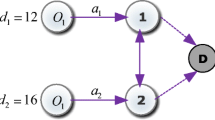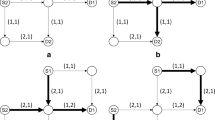Abstract
Disasters such as earthquake or tsunami can easily take the lives of thousands of people and millions worth of property in a fleeting moment. A successful emergency evacuation plan is critical in response to disasters. In this paper, we seek to investigate the multi-source, multi-destination evacuation problem. First, we construct a mixed integer linear programming model. Second, based on K shortest paths and user equilibrium, we propose a novel algorithm (hereafter KPUE), whose complexity is polynomial in the numbers of nodes and evacuees. Finally, we demonstrate the effectiveness of algorithm KPUE by a real evacuation network in Shanghai, China. The numerical examples show that the average computation time of the proposed algorithm is 95% less than that of IBM ILOG CPLEX solver and the optimality gap is no more than 5%.





Similar content being viewed by others
References
Anon. (1984). Formulations of the DYNEV and I-DYNEV traffic simulation models used in ESF. Technical report, Federal Emergency Management Agency.
Bish, D. R., & Sherali, H. D. (2013). Aggregate-level demand management in evacuation planning. European Journal of Operational Research, 224(1), 79–92.
Blake, E., & Zelinsky, D. (2017). National hurricane center tropical cyclone report: Hurricane Harvey. AL092017 August.
Burkard, R. E., Dlaska, K., & Klinz, B. (1993). The quickest flow problem. Zeitschrift für Operations Research, 37(1), 31–58.
Campos, V., Bandeira, R., & Bandeira, A. (2012). A method for evacuation route planning in disaster situations. Procedia-Social and Behavioral Sciences, 54, 503–512.
Chalmet, L., Francis, R., & Saunders, P. (1982). Network models for building evacuation. Management Science, 28(1), 86–105.
Chen, P. H., & Feng, F. (2009). A fast flow control algorithm for real-time emergency evacuation in large indoor areas. Fire Safety Journal, 44(5), 732–740.
Cherkassky, B. V., Goldberg, A. V., & Radzik, T. (1996). Shortest paths algorithms: Theory and experimental evaluation. Mathematical Programming, 73(2), 129–174.
Chiu, Y. C., & Zheng, H. (2007). Real-time mobilization decisions for multi-priority emergency response resources and evacuation groups: Model formulation and solution. Transportation Research Part E: Logistics and Transportation Review, 43(6), 710–736.
Chiu, Y. C., Zheng, H., Villalobos, J., & Gautam, B. (2007). Modeling no-notice mass evacuation using a dynamic traffic flow optimization model. IIE Transactions, 39(1), 83–94.
Choi, T. M., Cheng, T., & Zhao, X. (2016). Multi-methodological research in operations management. Production and Operations Management, 25(3), 379–389.
Contreras, I., Fernández, E., & Reinelt, G. (2012). Minimizing the maximum travel time in a combined model of facility location and network design. Omega, 40(6), 847–860.
Cova, T. J., & Johnson, J. P. (2003). A network flow model for lane-based evacuation routing. Transportation Research Part A: Policy and Practice, 37(7), 579–604.
Dhingra, V., & Roy, D. (2015). Modeling emergency evacuation with time and resource constraints: A case study from gujarat. Socio-Economic Planning Sciences, 51, 23–33.
Eppstein, D. (1998). Finding the k shortest paths. SIAM Journal on computing, 28(2), 652–673.
Floridajobs. (2010). Florida keys local hurricane policies. http://www.floridajobs.org/fdcp/dcp/acsc/Files/Hurricane/FLKeysLocalHurricanePolicies.pdf.
Gupta, A., & Yadav, P. K. (2004). SAFE-R: A new model to study the evacuation profile of a building. Fire Safety Journal, 39(7), 539–556.
Hamacher, H. W., & Tjandra, S. A. (2002). Mathematical modelling of evacuation problems: A state of art. Pedestrian and evacuation dynamics (pp. 227–266). Berlin: Springer.
He, X., Zheng, H., & Peeta, S. (2015). Model and a solution algorithm for the dynamic resource allocation problem for large-scale transportation network evacuation. Transportation Research Part C: Emerging Technologies, 59, 233–247.
Heintz, J., & Mahoney, M. (2012). Guidelines for design of structures for vertical evacuation from tsunamis. Technical report, Federal Emergency Management Agency.
Hobeika, A. G., & Kim, C. (1998). Comparison of traffic assignments in evacuation modeling. IEEE Transactions on Engineering Management, 45(2), 192–198.
Hoppe, B., & Tardos, É. (2000). The quickest transshipment problem. Mathematics of Operations Research, 25(1), 36–62.
Knabb, R. D., Brown, D. P., & Rhome, J. R. (2006). Tropical cyclone report, hurricane Rita, 18–26 September 2005. National Hurricane Center.
Kretz, T., Lehmann, K., & Hofsäß, I. (2014). User equilibrium route assignment for microscopic pedestrian simulation. Advances in Complex Systems, 17(02), 1450,010.
Latin, A. (2016). Hurricane matthew: Haiti south ’90% destroyed’. http://www.bbc.co.uk/news/world-latin-america-37596222.
Leo, G., Lodi, A., Tubertini, P., & Di Martino, M. (2016). Emergency department management in Lazio, Italy. Omega, 58, 128–138.
Lim, G. J., Zangeneh, S., Baharnemati, M. R., & Assavapokee, T. (2012). A capacitated network flow optimization approach for short notice evacuation planning. European Journal of Operational Research, 223(1), 234–245.
Liu, H. X., Ban, J. X., Ma, W., & Mirchandani, P. B. (2007). Model reference adaptive control framework for real-time traffic management under emergency evacuation. Journal of Urban Planning and Development, 133(1), 43–50.
Lu, Q., George, B., & Shekhar, S. (2005). Capacity constrained routing algorithms for evacuation planning: A summary of results In SSTD (pp. 291–307). Springer.
Lu, Q., Huang, Y., & Shekhar, S. (2003). Evacuation planning: A capacity constrained routing approach. Intelligence and Security Informatics, 64, 959–959.
Murray-Tuite, P., & Wolshon, B. (2013). Evacuation transportation modeling: An overview of research, development, and practice. Transportation Research Part C: Emerging Technologies, 27, 25–45.
Paul, N. R., Lunday, B. J., & Nurre, S. G. (2017). A multiobjective, maximal conditional covering location problem applied to the relocation of hierarchical emergency response facilities. Omega, 66, 147–158.
Pursals, S. C., & Garzón, F. G. (2009). Optimal building evacuation time considering evacuation routes. European Journal of Operational Research, 192(2), 692–699.
Pyakurel, U., Dhamala, T. N., & Dempe, S. (2017). Efficient continuous contraflow algorithms for evacuation planning problems. Annals of Operations Research, 254(1–2), 335–364.
RSS. (2015). Report for 2014 shanghai stampede. http://politics.people.com.cn/n/2015/0121/c1001-26424342.html.
Saadatseresht, M., Mansourian, A., & Taleai, M. (2009). Evacuation planning using multiobjective evolutionary optimization approach. European Journal of Operational Research, 198(1), 305–314.
Sayyady, F., & Eksioglu, S. D. (2010). Optimizing the use of public transit system during no-notice evacuation of urban areas. Computers and Industrial Engineering, 59(4), 488–495.
Sheffi, Y., Mahmassani, H., & Powell, W. B. (1982). A transportation network evacuation model. Transportation Research Part A: General, 16(3), 209–218.
Southworth, F. (1991). Regional evacuation modeling: A state-of-the-art review. New York: Center for Transportation Analysis, OAK Ridge National Laboratory.
Stepanov, A., & Smith, J. M. (2009). Multi-objective evacuation routing in transportation networks. European Journal of Operational Research, 198(2), 435–446.
Üster, H., Wang, X., & Yates, J. T. (2018). Strategic evacuation network design (send) under cost and time considerations. Transportation Research Part B: Methodological, 107, 124–145.
Xie, C., & Turnquist, M. A. (2011). Lane-based evacuation network optimization: An integrated lagrangian relaxation and tabu search approach. Transportation Research Part C: Emerging Technologies, 19(1), 40–63.
Xinhua. (2015). Typhoon chan-hom lands in e china, wreaks havoc. http://news.xinhuanet.com/english/2015-07/11/c_134403551.htm.
Zhang, X., & Chang, G. I. (2014). A dynamic evacuation model for pedestrian–vehicle mixed-flow networks. Transportation Research Part C: Emerging Technologies, 40, 75–92.
Acknowledgements
The first author’s work was partially supported by the National Natural Science Foundation of China (Grant Nos. 71201093, 71571111), the Innovation Method Fund of China (Grant No. 2018IM020200), and the Fundamental Research Funds of Shandong University (Grant No. 2018JC055). The corresponding and third author’s work was partially supported by the National Natural Science Foundation of China (Grant Nos. 71871063, 71371052). The authors also would like to thank the Qilu Young Scholars and Tang Scholars of Shandong University for financial and technical supports.
Author information
Authors and Affiliations
Corresponding author
Appendices
Proof
Proof of Proposition 1
We define \(T_a^*\) as the optimal solution value and \(N_a^{k,*}\) as the corresponding number of evacuees that are allocated to path \(p_a^k\). According to the definition of \(T_a\), we have \(T_a=\max _{1 \le k \le \hat{K}(a)}\{t_a^k(D_0)-1+\left\lceil \frac{N_a^{k}}{f_a^k} \right\rceil \}\). Hence, we have
\(\square \)
Summing over k, we can get \(T_a^* \cdot \sum _{k=1}^{\hat{K}(a)}{f_a^k} \ge \sum _{k=1}^{\hat{K}(a)}(t_a^k(D_0)-1)f_a^k+{ ICS}_a\). We have
We denote
In the following, we proceed the analysis according two cases: (a) \(\overline{T}_a\) is integral; (b) \(\overline{T}_a\) is fractional.
Case (a) If \(\overline{T}_a\) is integral, \(\overline{N}_a^k\) can be evacuated in \(\overline{T}_a\), and a total of \(\sum _{k=1}^{\hat{K}(a)}{\overline{N}_a^k}={ ICS}_a\) people can be evacuated.
Case (b) If \(\overline{T}_a\) is fractional, denote \(\hat{N}_a^k=\left\lceil \overline{N}_a^k \right\rceil \), and \(\hat{N}_a^k\) people can be evacuated in \(\left\lceil \overline{T}_a \right\rceil \).
Because \(\left\lceil \frac{\overline{N}_a^k}{f_a^k}\right\rceil \ge \frac{\overline{N}_a^k}{f_a^k}\), we can get \(\left\lceil \frac{\overline{N}_a^k}{f_a^k} \right\rceil \cdot f_a^k \ge \overline{N}_a^k\). Hence, we have \(\left\lceil \frac{\overline{N}_a^k}{f_a^k} \right\rceil \cdot f_a^k \ge \left\lceil \overline{N}_a^k\right\rceil =\hat{N}_a^k\) and \(\left\lceil \frac{\overline{N}_a^k}{f_a^k} \right\rceil \ge \frac{\hat{N}_a^k}{f_a^k}\). So, we also have

Because \(\overline{N}_a^k \le \hat{N}_a^k\), we have

According to (A.1) and (A.2), we can get \(\left\lceil \frac{\overline{N}_a^k}{f_a^k} \right\rceil = \left\lceil \frac{\hat{N}_a^k}{f_a^k} \right\rceil \). Hence, sending \(\hat{N}_a^k\) people to super destination node \(D_0\) need \(\left\lceil \frac{\overline{N}_a^k}{f_a^k} \right\rceil +t_a^k(D_0)-1=\left\lceil \overline{T}_a \right\rceil \). All \(\sum _{k=1}^{\hat{K}(a)}{N_a^k}> { ICS}_a\) people can be evacuated in \(\left\lceil \overline{T}_a \right\rceil \).
To sum up case (a) and (b), \(T_a^*=\left\lceil \frac{\sum _{k=1}^{\hat{K}(a)}{(t_a^k(D_0)-1)f_a^k}+{ ICS}_a}{\sum _{k=1}^{\hat{K}(a)}{f_a^k}}\right\rceil \) is the optimal solution.
Data and evacuation networks of the literature (Chalmet et al. 1982; Lu et al. 2005)
In Sect. 5, we present different scenarios for numerical study. The evacuation network of Scenario S01 and S02 are presented in Fig. 6. The number of evacuees at source nodes [N1, N2, N3] from S01 are [10, 5, 15], while the number of evacuees at source nodes [N1, N2, N3] from S02 are [220, 240, 450]. The evacuation network of Scenarios S11, S12, S13, S14, S15 and S16 are presented in Fig. 1. The number of evacuees at source nodes [N1, N2, N3] from S11 are [220, 240, 450]. The number of evacuees at source nodes [N1, N2, N3, N4] from scenarios S12, S13, S14 and S15 are [150, 350, 305, 105], [300, 700, 600, 200], [500, 1150, 1050, 300], [850, 1800, 1550, 400], respectively. The number of evacuees at source nodes [N1, N2, N3, N4, N5, N6, N7, N8] from scenario S16 are [100, 100, 200, 100, 110, 100, 100, 100]. The evacuation network of Scenario S21 are presented in Fig. 7. The number of evacuees at source nodes [N1, N2, N3] from S21 are [220, 240, 450].
Evacuation network from Lu et al. (2005)
Evacuation network from Chalmet et al. (1982)
Rights and permissions
About this article
Cite this article
Zhang, J., Liu, Y., Zhao, Y. et al. Emergency evacuation problem for a multi-source and multi-destination transportation network: mathematical model and case study. Ann Oper Res 291, 1153–1181 (2020). https://doi.org/10.1007/s10479-018-3102-x
Published:
Issue Date:
DOI: https://doi.org/10.1007/s10479-018-3102-x






